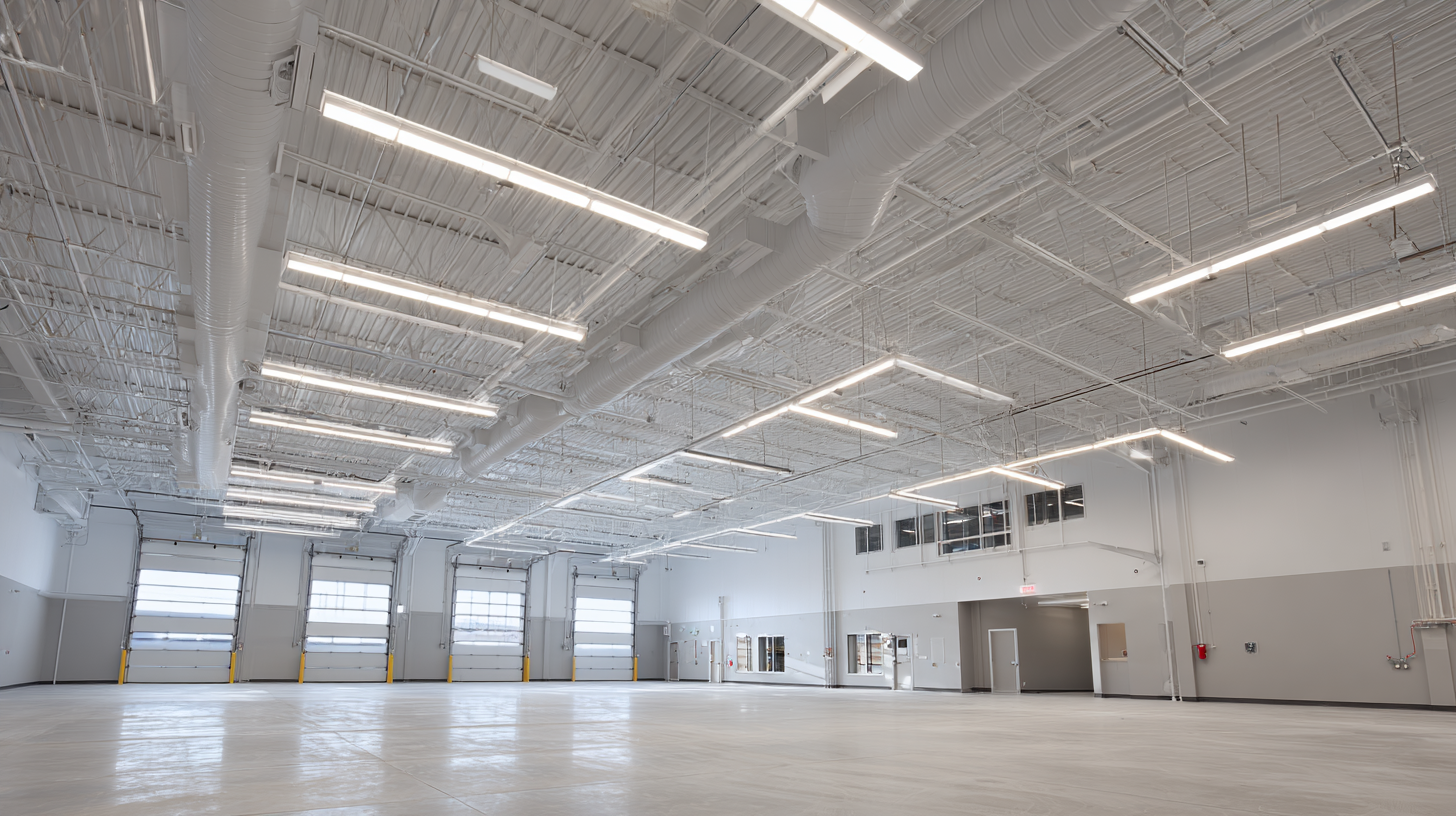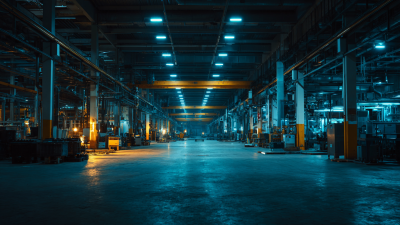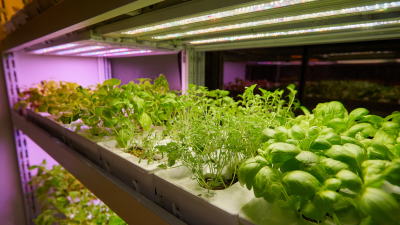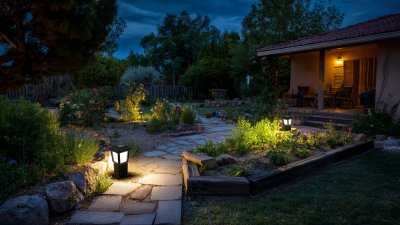The Future of Industrial Lighting How LED High Bay Fixtures Revolutionize Workspaces
The evolution of industrial lighting has taken a dramatic turn with the advent of LED high bay fixtures, significantly enhancing productivity and energy efficiency in various workspaces. According to a report by the U.S. Department of Energy, widespread adoption of LED technology can reduce lighting energy use by up to 75% compared to traditional fluorescent systems, yielding substantial cost savings.

Moreover, the market for LED high bay fixtures is projected to grow at a compound annual growth rate (CAGR) of 10.4% from 2022 to 2028, reflecting the increasing demand for sustainable lighting solutions in warehouses, manufacturing plants, and large retail spaces. The superior lifespan of LED fixtures—typically exceeding 50,000 hours—further underscores their role in revolutionizing work environments, minimizing maintenance costs and downtime.
As businesses seek to optimize their operations while adhering to eco-friendly standards, the transition to LED high bay fixtures is not just a trend but a necessity for the future of industrial illumination.
The Role of LED Technology in Transforming Industrial Lighting
The revolution in industrial lighting is predominantly driven by advancements in LED technology. According to a report by the Department of Energy, LED lighting is projected to achieve a 75% market share by 2030, largely due to its energy efficiency and long lifespan. Traditional lighting solutions can waste up to 90% of their energy as heat, whereas LED fixtures convert over 90% of electricity into light. This not only reduces energy bills but also minimizes the carbon footprint of industrial operations.
Moreover, LED high bay fixtures enhance workspace safety and productivity. They provide superior illumination quality with high Color Rendering Index (CRI), allowing workers to perceive colors accurately and reducing the likelihood of accidents. A study from the Illuminating Engineering Society noted that improved lighting not only boosts morale but can also contribute to a 20% increase in productivity in industrial environments.
**Tips for Implementation:** Ensure proper placement of LED fixtures to maximize light distribution throughout the workspace. Regularly maintain and clean the fixtures to sustain their efficiency and lifespan. Additionally, consider integrating smart lighting controls to optimize energy use, adapting light levels based on occupancy and time of day, which can further reduce operational costs.

Key Benefits of Switching to LED High Bay Fixtures
LED high bay fixtures have become a game changer for industrial lighting, boasting key benefits that are shaping modern workspaces. According to a report by the Department of Energy, LED lighting can achieve energy savings of 65% to 70% compared to traditional fluorescent fixtures. This significant reduction in energy consumption doesn't just benefit the environment; it also translates to substantial cost savings for businesses. Over time, these savings can amount to thousands of dollars annually, making the switch to LED high bay lights an economically savvy choice.
Moreover, the longevity of LED fixtures is another compelling advantage. Industry data indicates that LED lights can last up to 50,000 hours, significantly outpacing traditional options that typically last around 15,000 to 20,000 hours. This means less frequent replacements and reduced maintenance costs, further adding to the overall savings. Additionally, the superior light quality and uniform illumination provided by LED high bay lighting enhance worker productivity and safety in various industrial settings, creating a more efficient and conducive work environment.
The Future of Industrial Lighting: Key Benefits of Switching to LED High Bay Fixtures
Comparing Traditional Lighting Solutions with LED Options
The evolution of industrial lighting has been significantly influenced by the introduction of LED technology, marking a paradigm shift from traditional lighting solutions. Traditionally, many workplaces relied on incandescent and fluorescent lights, which, despite their ubiquity, have numerous drawbacks, including high energy consumption and shorter lifespans. In contrast, LED fixtures not only offer superior energy efficiency but also last significantly longer, reducing the frequency and cost of replacements.
The affordability of LED technology is another crucial factor driving its adoption. Recent advancements have led to a steep decline in LED prices, making it easier for consumers and businesses to transition away from conventional bulbs. As people increasingly recognize the long-term savings associated with LEDs—both in terms of energy bills and maintenance—there is a growing shift towards these innovative lighting solutions. This transition is further reinforced by ongoing research and development in the semiconductor lighting industry, establishing LEDs as the preferred choice for modern workspaces and enhancing overall productivity and workplace ambiance.
Impact of LED High Bay Fixtures on Workplace Productivity and Safety
LED high bay fixtures have emerged as a transformative technology in industrial lighting, significantly impacting workplace productivity and safety. These advanced lighting solutions are designed to illuminate large spaces with high ceilings, ensuring that every corner of the workspace is brightly lit. Improved visibility fosters greater accuracy in tasks, reduces the likelihood of errors, and enhances overall efficiency. Employees operating in well-lit environments are more likely to stay focused, complete their work tasks in a timely manner, and maintain a higher level of engagement throughout the day.

Safety is another crucial aspect benefitting from the adoption of LED high bay fixtures. Traditional lighting often leads to shadows and dark spots, which can increase the risk of accidents and injuries. In contrast, LED high bay lights provide uniform illumination, helping to eliminate these hazardous areas and allowing workers to navigate the workspace safely. Moreover, LED technology is known for its durability and long lifespan, reducing the frequency of replacements and outages that can disrupt operations. The combination of enhanced lighting quality and safety measures makes LED high bay fixtures a vital investment for modern industrial workspaces.
Future Trends in Industrial Lighting: Innovations and Sustainability
The industrial lighting sector is undergoing a significant transformation driven by innovations in LED high bay fixtures. As businesses increasingly recognize the importance of energy efficiency and sustainability, LED technology is making its mark by reducing energy consumption while enhancing illumination quality. Recent studies project the global market size for flashlights to reach approximately $7.43 billion by 2025, with an anticipated growth to about $9.75 billion by 2033, resulting in a compound annual growth rate (CAGR) of 4.1%. This growth reflects the trend towards adopting more efficient lighting solutions in industrial settings.
Moreover, the renewable energy market is on a promising trajectory, reflecting a broader shift towards sustainable practices. The global renewable energy market size is expected to grow from $1,020.94 billion in 2024 to approximately $1,578.08 billion by 2032. This highlights a growing commitment to eco-friendly initiatives across industries, including the implementation of LED technology in lighting solutions. As these trends converge, businesses that embrace innovative and sustainable lighting options will not only improve their operational efficiency but also contribute positively to the environment, aligning with global sustainability goals.
The Future of Industrial Lighting: How LED High Bay Fixtures Revolutionize Workspaces
| Dimension | Value |
|---|---|
| Lifespan of LED High Bay Fixtures | 50,000 hours |
| Energy Efficiency | Up to 80% less energy consumption compared to traditional lighting |
| Environment Impact | No hazardous materials, fully recyclable |
| Light Output | Up to 30,000 lumens |
| Color Temperature Options | 3000K, 4000K, and 5000K |
| Return on Investment (ROI) | Average ROI within 2-3 years |
| Typical Applications | Warehouses, manufacturing plants, gymnasiums |
| Smart Lighting Integration | Compatible with IoT systems for remote monitoring and control |
Related Posts
-

How to Choose the Right LED High Bay Fixtures for Your Commercial Space
-

Transforming Workspaces: The Ultimate Guide to Energy Efficiency with Industrial LED Lighting
-

Maximizing Indoor Gardening Success: The Ultimate Guide to Choosing the Right Grow Lights
-

Transform Your Garden: Explore the Rise of Solar LED Outdoor Lights with 35% Energy Savings!
-

How to Improve Outdoor Safety and Energy Efficiency with LED Wall Packs
-

Exploring Solar Lights Market Trends at the 138th China Import and Export Fair 2025
